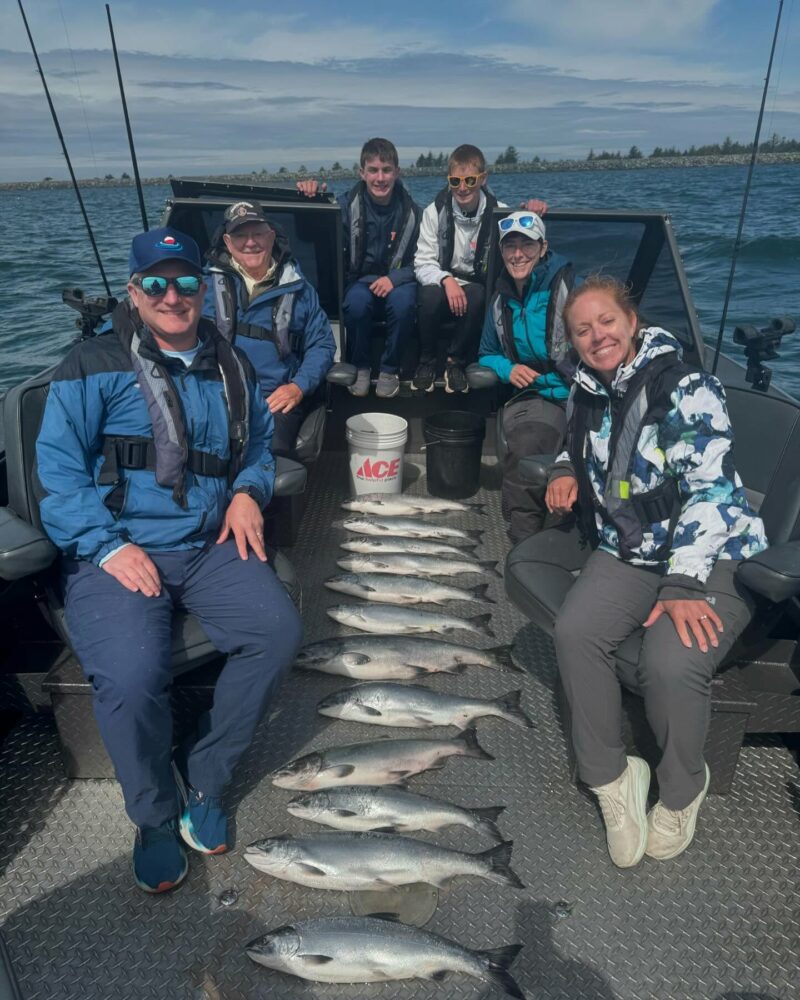What to Expect on a Family-Friendly Salmon Trip Near Portland
If you are thinking about a family-friendly salmon trip near Portland, picture an early morning on the river. Most trips meet near sunrise at a marina or boat ramp on the Columbia or Willamette. You park, meet your captain, and step aboard while the water is still quiet.
The first few minutes on the boat are about safety and comfort. We do quick introductions, fit kids and adults with life jackets, and go over simple rules like where to sit when the boat is running and how to move safely on deck. Once everyone is settled, we ease away from the dock and head toward the first fishing area.

Safety and Comfort for Parents and Kids
Most parents want to know two things: how safe the boat is and whether the kids will have fun. A good family-focused guide designs the day around those concerns. Everyone wears a properly fitted life jacket, the boat layout keeps little feet away from danger, and there is always a clear, secure spot where kids can sit or stand when we are moving.
I expect kids to wiggle, talk, and explore; that is part of the fun of fishing with kids near Portland. If someone needs a snack, a bathroom stop, or a quiet moment, we slow things down so nobody feels pressured to act like a seasoned angler.
Most children enjoy having a job, so I give them simple roles that match their age. Younger kids might help pick lure colors or be the official rod tip watcher. Older kids can help set a rod in the holder, crank the reel when we check gear, or take the lead on fighting a fish with coaching.
How the Salmon Fishing Works
You do not need any experience to enjoy a Portland salmon fishing charter. I provide the rods, reels, bait, and lures, and I set everything up before you ever hold a rod. Around Portland, we usually troll, which means we move slowly while our lines trail behind the boat, and the lures swim like small baitfish that salmon like to chase.
Some days, we might anchor in a travel lane and let the river current work the gear instead. In either case, your job is simple. Enjoy the scenery, talk with your family, and keep an eye on the rods. When a salmon bites, that quiet rod suddenly bends. I grab it from the holder, hand it to whoever is up next, and talk them through the fight to the net.
I remind kids that the details are my job. Their job is to keep the rod up, keep reeling, and enjoy the excitement of feeling a strong fish pull back. Parents can help younger kids turn the handle or switch off when arms get tired, and it usually turns into a boat-wide cheer when the fish finally slides into the net.

What to Bring and How to Dress
The weather on the Columbia and Willamette can change during a single trip, so layers are the best plan. A comfortable shirt, a warm sweatshirt or fleece, and a light waterproof jacket give you options as the temperature moves from cool dawn to brighter midday. Closed-toe shoes with a good grip keep everyone steady on a damp deck.
Sun protection still matters on cloudy days because light reflects off the water, so pack hats, sunglasses, and sunscreen for the whole family. A small bag with extra clothes for the kids and a phone or camera in a waterproof case keeps you ready for spills and splashes. Simple snacks and drinks, like granola bars, sandwiches, fruit, and water or juice boxes, help everyone stay comfortable.
Redefining Success on the River
The best family fishing trips Portland, Oregon, offers are not judged only by how many salmon ride home in the cooler. We work hard for bites, and landing a bright fish is a thrill for everyone. But the real measure of success on a family trip is whether kids gain confidence, parents relax, and everyone steps off the boat smiling and talking about the day.
Can you picture the small moments that come with a day on the water? A child holding a rod for the first time. A teen looking up from their phone to watch the rod tips. Parents sitting side by side with coffee while the city wakes up in the distance.

Book Your Family Salmon Adventure
If this sounds like the kind of day you want with your family, the next step is simple. Choose a professional local guide, pick a date, and get your spot reserved. Let your captain know you want a kid-focused trip so they can tailor the plan to your group and your goals.
A good guide will handle the boat, the gear, the safety, and the salmon tactics. You bring your family, your questions, and your sense of adventure. When you are ready to book a family-friendly salmon trip near Portland with an experienced Portland salmon fishing charter, reach out, reserve your date, and let us take care of the details so you can focus on having fun together on the water.
